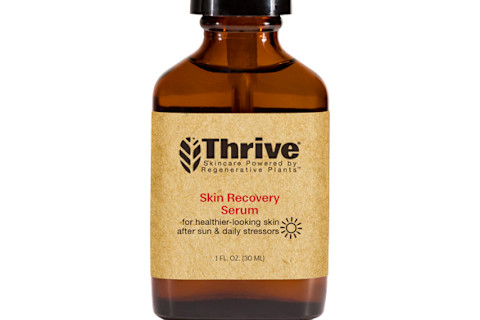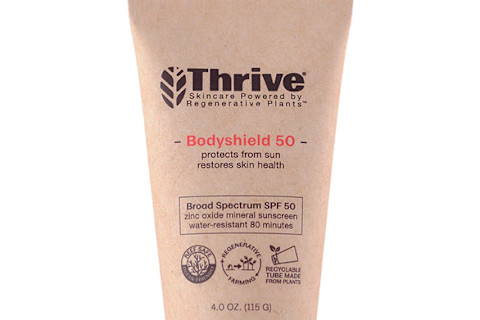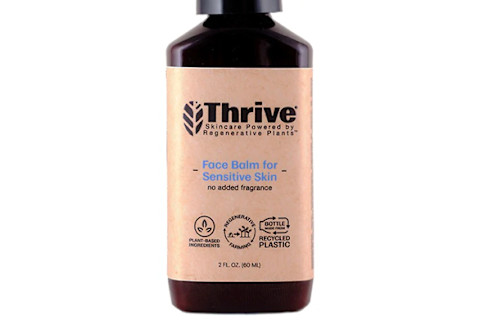How This Regenerative Farm Is Producing Better Beauty Products

I think about resiliency a lot. Resiliency is the power not only to overcome challenges but to become stronger because of them. I think after the last several years, many of us can appreciate that concept in some way. More and more it's a quality I identify with and try to cultivate in myself. And in an attempt to do so, I often push myself too hard or run myself too thin. I often think if I can just get past whatever hurdle is in front of me at that given moment, I'll strengthen my resolve. But the problem with this particular growth strategy is it often leaves one feeling depleted in the end.
And that's because to become more resilient, we actually need regeneration. To flourish, we must allow ourselves to become strengthened by the community surrounding us. We have evolved in such a way that we can only survive by opting into this cycle of give-and-take.
It's actually something I was reminded of recently, while on a trip to a co-op in the Costa Rican rain forest to learn about regenerative farming. (It may seem like a stretch to learn something about yourself while listening to an ethnobotanist explain eco-friendly farming methods, but given we are of the earth, I think it's important to glean life lessons from the planet.) On my trip, I saw this regenerative cycle in action—as well as the thriving land, crop, and community it produced. Its use seems more vital now than ever.
Regenerative farming and a better world.
We've written about regenerative farming here at mindbodygreen before, but for those unacquainted with the concept, regenerative agriculture is a holistic, sustainable approach to farming that aims to restore the nutrient content of the soil during the farming process—as well as sustaining the world around it with conservation and rehabilitation measures.
Large-scale commercial farming is characterized by large monocrop fields, over-tilling, and the use of pesticides, herbicides, and synthetic fertilizer. These efforts deplete the soil, resulting in eroded land, a significantly depleted planet biome, and reduced quality of output. This has a severe environmental impact on a broad scale.
One very important part of that ecosystem is the microorganisms in the soil (or as we call it, the planet's microbiome). As our sustainability editor Emma Loewe writes, "teeny-tiny microorganisms that support plant growth and clean up the environment in the process. There are more organisms in a handful of soil than humans who have ever lived, and they all help sequester carbon from the atmosphere and trap it in the ground." By reducing their diversity, we risk losing this benefit.
In fact, a report by the Rodale Institute, an organic agriculture research nonprofit, suggests that if all our land capable of being farmed or ranched was managed with soil health in mind, it could trap all the annual CO2 emissions produced by humans and then some. The situation becomes more dire when you consider the research on the opposite end of the spectrum: Previous studies have found that if we don't make this transition, most of the world's topsoil will be depleted within the next 60 years.
Hence, the urgent need for regenerative farming.
According to skin care brand Thrive Natural Care's CEO and co-founder Alex McIntosh, their core mission is to identify areas of land erosion due to mainstream agriculture, use regenerative practices to revive it, and create better skin care products in the process. McIntosh shares with me that the guiding ethos of his life and the brand is to "leave it better than you found it," which is a very succinct way to describe regenerative agriculture.
But I think it's something better understood when visualized. While in Costa Rica, Mario Garcia Quesada, founding director of regenerative operations at Thrive, walked us through this in action. Garcia Quesada is a field botanist who's been at the brand for about 10 years and manages their regenerative supply chain by working with the farmers, molding best practices, and helping identify new locations. The Costa Rican soil and farmland are something he knows like the back of his hand.
He showed us a cooperative farm in Coopecuna in Limón, one of Thrive's partnership farms that grows juanilama, a native botanical that they use in a variety of their products, among other crops. It's a women-led co-op, with members coming from nearby communities. The farm has a "nursery" section where they nurture younger plants and experiment with new growing methods, as well as a nearby field where much of the actual crop is grown. On our downpour-soaked trip—it is a rain forest after all—we walked through the lush nursery.
Alongside McIntosh, Garcia Quesada walked us through the bustling ecosystem, full of frogs, insects, and other living organisms (ourselves included). The ground was full of foliage and shells of harvested plants. The sky was shielded by towering trees, providing shade from the midday sun, as well as nutrients when the leaves fell to feed the topsoil. Below us, roots carried nutrients, precious carbon, and communication between the diverse collection of botanicals.
This system is mimicked in the larger crop field next door, where the farmers are able to tend to and harvest the juanilama plant year-round—even in the dry season. They recreate the elements of a rain forest's most optimal environment, like utilizing cover crops, leaving the dying leaves so their remains can pump nutrients back into the soil, and using compatible plants as a "living fence" surrounding the crop for botanical variety. In comparison to the derelict commercial farms, there's an ecosystem here. And with the environmental community, the juanilama plant flourishes.
Once collected, the plant goes into the co-op's own distillation machine, where it becomes an essential oil. Here, they turn a raw material into liquid gold—while the farm can make money from the raw botanicals themselves, by being able to turn it into a more valuable asset, like an oil or extract, they increase their profit. The land's resource isn't just excavated by an outside company, it's celebrated by the community that grows it.
When I asked the group what their favorite essential oil was, the co-op's president smiled, laughed, and spoke to Garcia Quesada (who was translating). The rest of the co-op members laughed with him as they heard his answer. "That's like asking who is my favorite child," Garcia Quesada translated for me.
Earth-enhanced products bring a new life to natural skin care.
If we ended the story here, I'm sure many mindbodygreen community members would be compelled to check them out. But I always appreciate an ingredient and formula hook, which is why I loved talking to Laura Arce Aita, Thrive's founding director of research and development. She's as careful at explaining the formulas and ingredients to me as she is with crafting the formula itself.
She says that because of these regeneratively grown ingredients, the overall formulas are even stronger. It's actually a concept that has been studied in our food sources—and is now being expanded into the personal care space.
When plants are allowed to grow as their natural ecosystems designed them to, they are stronger and contain higher nutritional content. In these environments, they are exposed to more "stressors"—and while this sounds like a bad thing, it's actually highly beneficial for plants in the long run. For example, one study even showed that "wounding" the leaves of strawberry plants the same way insects do in their natural environment (insects that would be eradicated by commercial farming) resulted in a higher concentration of antioxidant compounds1.
This is true of these Costa Rican botanicals too. An independent study showed that the juanilama oil has potent antibacterial, antifungal, and antioxidant properties. (This is why it's been used as a medicinal topical for ages in Costa Rica.) To put this in perspective, it has 87% more antioxidant capacities than vitamin E.
These resilient botanicals are then surrounded by clean, natural formulas. For example the brand's bestselling Bodysheild 50 uses non-nano zinc oxide for UVA and UVB protection, botanical oils and glycerin for a smooth application, and the brand's juanilama oil for superpowered antioxidants.
Ecosystems inspire strength.
Given the state of the environment right now, it's easy to become cynical and distrusting of the world around us—believing in a better world is what's hard. But doing hard things? Well, that's what makes us stronger.



